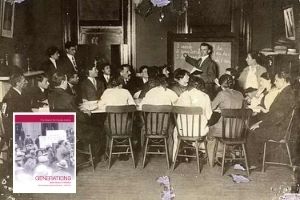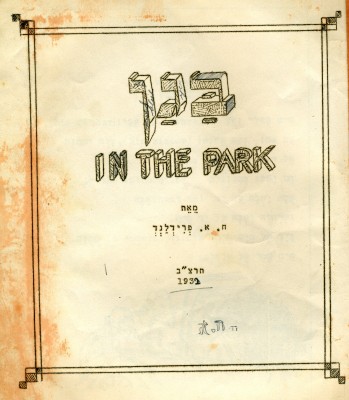A “Children’s Playground” and “Centre for Adults” Part II

Article by Jennifer Vess. Originally published in Generations 2009-2010: 50th Anniversary Double Issue: The Search for Social Justice.
Part II: A Jewish Spirit
One of the first orders of business for the newly-installed directors was to choose a name for the merged institution. The meeting minutes do not detail the search for the name or the discussions surrounding it, but a special committee was formed and after several weeks the secretary recorded the choice of the Jewish Educational Alliance. The directors could have simply gone with the name Educational Alliance, taking their example from the New York City Jewish settlement house founded twenty years earlier. But in Baltimore the founders wanted to emphasize the Jewish nature of their endeavor. The articles of the merger firmly state that “The head worker of the organization shall be a Jew, and a Jewish spirit shall pervade the work of the organization.”[1]

From the beginning, the JEA promoted Jewish education and hosted celebrations of Jewish holidays. Staff members wasted no time converting the old headquarters of the Maccabean House and the Daughters in Israel, which they used until a new building was constructed in 1913 (see sidebar). They immediately started a Sabbath school and soon after added a Hebrew school. Baltimore’s Jewish Comment newspaper described a series of Hanukkah events on December 17, 1909, barely a month after the JEA opened: the Sabbath and sewing schools celebrated with songs, recitations, and plays; the Mothers’ Meeting featured a candle-lighting and lecture by Dr. Guttmacher (the Reform rabbi of Baltimore Hebrew Congregation and husband of JEA board member Laura Guttmacher); and in the evening a dance was held. Announcements for Purim and Hanukkah parties and Passover-related events appeared in the Jewish Comment and later in the Baltimore Jewish Times from 1909 until the JEA closed in 1952.[2]
Jewish education encompassed all ages. The JEA held weekly Sabbath services specifically designed for children. Even its nursery school was infused with Jewish culture and history. In 1921 the meeting minutes recorded, “The need for stimulation of the children along Jewish lines was suggested. It was agreed that if Mrs. Erlanger who leads the Story Telling Class could combine Jewish Legend telling it would be a fine thing.” For older children and adults the JEA offered articles in its newsletter, The Alliance Citizen, as well as classes and lectures on Zionism, current events related to Jews around the world, and Jewish holidays.[3]
From its earliest years until it closed, the JEA was “a Jewish House,” its leaders insisted. “Altho not restricting our house to people of our faith, the Alliance wishes the community to have confidence in its Jewishness.”[4] This meant not only promoting Judaism within its walls, but also combating influences detrimental to Judaism in the outside world. In the 1920s the JEA worked with community leaders to counter the efforts of Christian missionaries, who had begun proselytizing on the street corners of East Baltimore in order to convert the Jewish immigrant population. The JEA director joined with the Down Town Committee against Christian Propaganda, which included Reform Rabbi Morris Lazaron, Orthodox Rabbi Avraham Schwartz, Conservative Rabbi Adolf Coblentz, and Mrs. Leonard Hecht. In a report delivered at the JEA’s October 1921 board meeting, the director described “an active campaign” against a missionary known as Mr. Berman. “His out-door meetings on corner of Baltimore St. + Central Ave. received a set back when J.E.A. obtained permit to hold meeting at same time on opposite corner in behalf of Larger City Springs and eventually won the crowd from his corner to J.E.A counter attraction.”[5]
Continue to Part III: Not Only a Children’s Playground
Notes:
[1] Jewish Comment, October 29, 1909.
[2] Jewish Comment, December 17, 1909; Isaac Aaronson, “Jewish Charities: A Settlement Diary,” January 1916, available at Google Books, books.google.com; “At the JEA,” Baltimore Jewish Times, December 7, 1951, p. 36.
[3] JEA meeting minutes, November 16, 1921 and December 4, 1915, MS 170, Folder 213, JMM; Aaronson, “Jewish Charities: A Settlement Diary;” The Alliance Citizen 1, No. 3 (May 1914).
[4] January 1921 report, JEA meeting minutes, MS 170, Folder 213.
[5] JEA meeting minutes, April 6, 1921 and October 5, 1921, MS 170, Folder 213.
